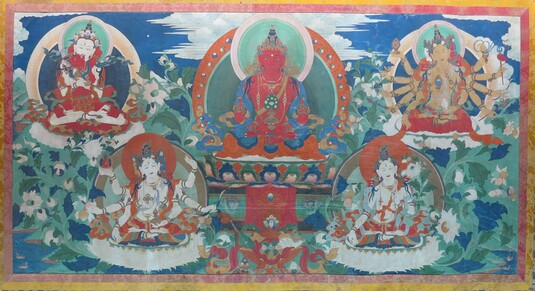
Item: Amitayus Buddha - Amitayus
| Origin Location | China |
|---|---|
| Date Range | 1800 - 1899 |
| Lineages | Gelug and Buddhist |
| Material | Ground Mineral Pigment on Cotton |
| Collection | Private |
Alternate Names: Aparimitayurjñana
Classification: Deity
Appearance: Buddha
Gender: Male
Amitayus Buddha accompanied by Chakrasamvara, Pratisara, Ushnishavijaya and Tara. All five figures have a peaceful appearance. Of the five figures two are male and three are female. Four figures are female if you count the consort of the white Chakrasamvara at the top left. The males and females can be distinguished by the male having a horizontal hairline above the forehead. The females have an oval face which is very clear to see in this composition. (See an example of male and female depictions).
There are five figures in this composition with the larger figure of Amitayus Buddha at the center. In this depiction Amitayus does not have the usual appearance of a Buddha but rather that of a peaceful deity characterized by a youthful body, wearing jewel ornaments and fine silk clothing. Amitayus is the Buddha of Immeasurable life. In this function related to immeasurable life, Amitayus is considered to be beneficial for extending the life span of the practitioners and devotees. His red colour is not related to this function but rather the typical colour associated with the two similar buddhas, Amitabha and Amitayus.
Three of the other four figures are also related to the extension of life and good health. At the top left is white Chakrasamvara embracing the consort Vajra Varahi who is red in colour. He holds two long-life vases in the two hands which are also folded around the consort.
At the lower left is the female deity Ushnishavijaya 'Victorious Crown Ornament' of the Buddha. She is so named because she was created from a ray of light that shone from the top of the Buddha's head. She has three faces and eight arms with each hand holding a different attribute, a symbolic object.
At the top right side is another female deity known as Pratisara. She is yellow in colour with four faces and twelve hands. Each hand holds a different attribute. Pratisara's main function is to remove many of life's obstacles such as ill-fortune, poor health, bad crops, bad weather, flooding and more. She is the only figure in the group of five which is not directly related to the fulfilment of long life. There are at least six different forms and traditions of Pratisara. This particular depiction with four faces and twelve hands is from the Vajravali text of the Indian teacher Abhayakaragupta.
At the lower right is a white Tara with one face and two hands. Her distinctive characteristics are the seven eyes on her body, three on the face, two on the palms of the hands and two on the soles of the feet.
All of the five figures have a peaceful appearance which is one of the three main types of appearances from the Eleven Figurative Forms found in Himalayan style art.
Surrounding the five figures are green lawns and ponds below with blue skies and white clouds above. Between each of the figures are stems and alternating blue and green leaves topped with white flower blossoms.
Jeff Watt 12-2015
Buddha Form | Female Form | Wrathful Form
Buddhist Deity: Amitayus Buddha (Aparimitāyurjñāna, 无量寿佛, སངས་རྒྱས་ཚེ་དཔག་མེད།)
Exhibition: Buddha Form (DM)
Collection of Dhargye Museum (Painting Gallery 1)
Subject: Three Long-life Deities
Collection of Dhargye Museum

